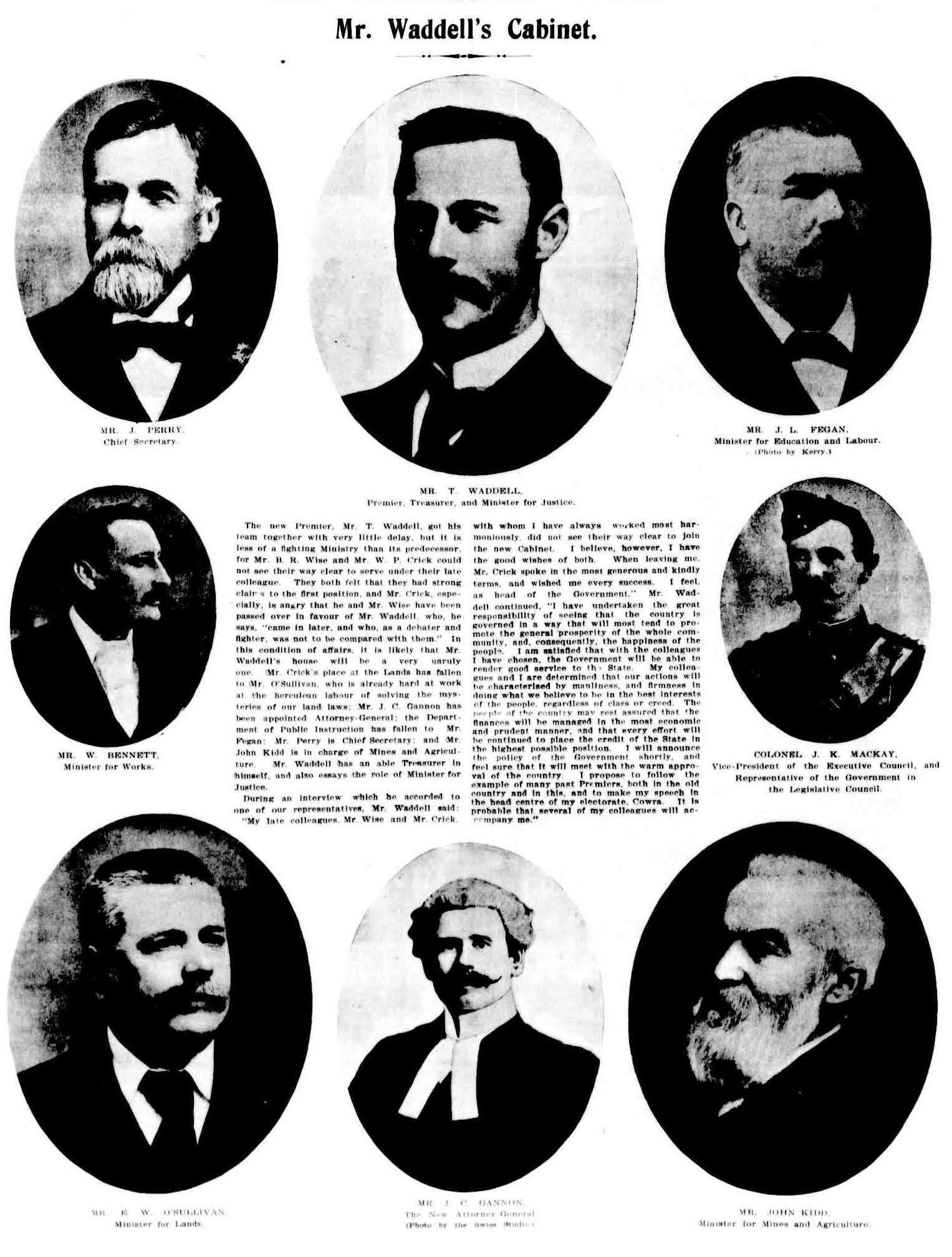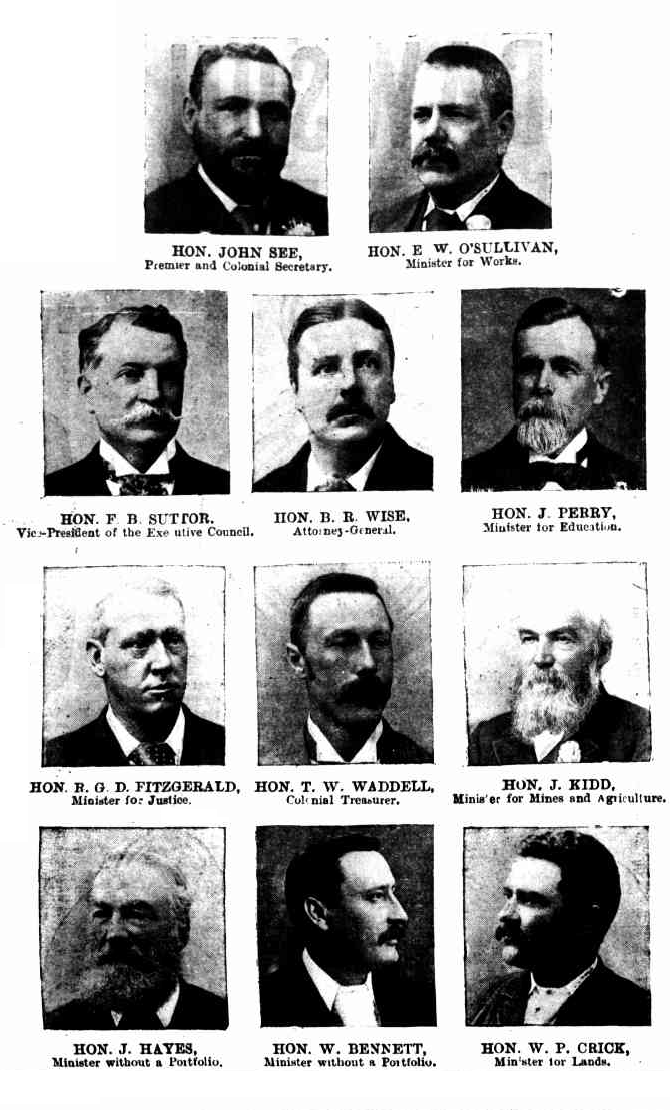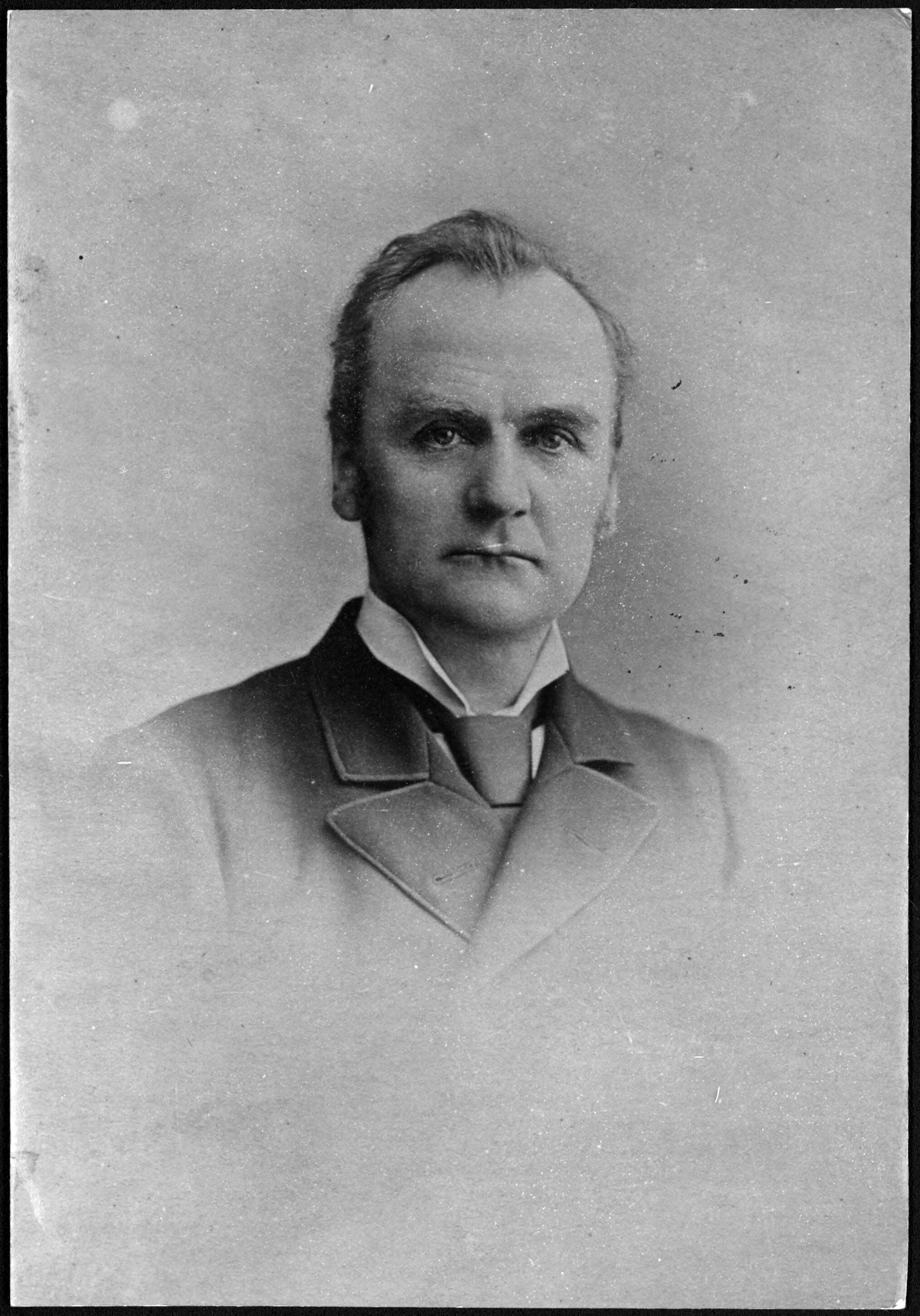|
Members Of The New South Wales Legislative Council, 1901–1904
Members of the New South Wales Legislative Council who served from 1901 to 1904 were appointed for life by the Governor on the advice of the Premier. This list includes members between the state election on 3 July 1901 and the state election on 6 August 1904. The President was Sir John Lackey until 23 May 1903 and then Sir Francis Suttor. Non-Labor party affiliations at this time were fluid, and especially in the Legislative Council regarded more as loose labels than genuine parties. See also * See ministry *Waddell ministry __NOTOC__ The Waddell ministry was the 31st ministry of the New South Wales Government, and was led by the 15th Premier, Thomas Waddell. The title of Premier was widely used to refer to the Leader of Government, but was not a formal position in ... Notes References {{DEFAULTSORT:Members of the New South Wales Legislative Council, 1901-1904 Members of New South Wales parliaments by term 20th-century Australian politicians ... [...More Info...] [...Related Items...] OR: [Wikipedia] [Google] [Baidu] |
New South Wales Legislative Council
The New South Wales Legislative Council, often referred to as the upper house, is one of the two chambers of the parliament of the Australian state of New South Wales. The other is the Legislative Assembly. Both sit at Parliament House in the state capital, Sydney. It is normal for legislation to be first deliberated on and passed by the Legislative Assembly before being considered by the Legislative Council, which acts in the main as a house of review. The Legislative Council has 42 members, elected by proportional representation in which the whole state is a single electorate. Members serve eight-year terms, which are staggered, with half the Council being elected every four years, roughly coinciding with elections to the Legislative Assembly. History The parliament of New South Wales is Australia's oldest legislature. It had its beginnings when New South Wales was a British colony under the control of the Governor, and was first established by the ''New South Wales Act ... [...More Info...] [...Related Items...] OR: [Wikipedia] [Google] [Baidu] |
Thomas Hawkins Smith
Thomas Hawkins Smith (11 April 1829 – 27 July 1902) was an English-born Australian politician. He was born at Quinton to farmer John Smith and Sarah Ann Hill. He emigrated to New South Wales in 1852, becoming a farmer on the Clarence River. He also owned property on the Richmond River, at Kyogle and in northern Queensland. On 7 January 1872 he married Emily Blanche Rothery. In 1892 he was appointed to the New South Wales Legislative Council by Premier George Dibbs. He served there until his death at Darling Point Darling Point is a harbourside eastern suburb of Sydney, Australia. It is 4 kilometres east of the Sydney central business district and is part of the local government area of Woollahra Council. Darling Point is bounded by Sydney Harbour to ... in 1902. References 1829 births 1902 deaths Members of the New South Wales Legislative Council 19th-century Australian politicians {{Australia-politician-stub ... [...More Info...] [...Related Items...] OR: [Wikipedia] [Google] [Baidu] |
Waddell Ministry
__NOTOC__ The Waddell ministry was the 31st ministry of the New South Wales Government, and was led by the 15th Premier, Thomas Waddell. The title of Premier was widely used to refer to the Leader of Government, but was not a formal position in the government until 1920. Instead the Premier was appointed to another portfolio, usually Colonial Secretary, however in this case Waddell chose to retain his previous portfolio of Colonial Treasurer. Waddell was elected to the New South Wales Legislative Assembly in 1887 as member for Bourke, serving in the See ministry, prior to assuming leadership of the Progressive Party following the retirement of Sir John See, KCMG due to ill health. The Governor, Sir Harry Rawson, was not prepared to appoint Paddy Crick as Premier, due to his excessive drinking in cabinet meetings, nor Bernhard Wise, who he regarded as unreliable. Waddell was appointed instead and both Crick and Wise declined to serve in his ministry. The three vacancies were f ... [...More Info...] [...Related Items...] OR: [Wikipedia] [Google] [Baidu] |
See Ministry
__NOTOC__ The See ministry was the 30th ministry of the New South Wales Government, and was led by the 14th Premier, Sir John See. The title of Premier was widely used to refer to the Leader of Government, but was not a formal position in the government until 1920. Instead the Premier was appointed to another portfolio, usually Colonial Secretary. See was elected to the New South Wales Legislative Assembly in 1880 as member for Grafton, serving in the Dibbs and Lyne ministries, prior to assuming leadership of the Progressive Party. Under the constitution, ministers in the Legislative Assembly were required to recontest their seats in an election when appointed. Such ministerial by-elections were usually uncontested and on this occasion there were only three new ministers, Robert Fitzgerald, John Kidd and Thomas Waddell and all were re-elected unopposed. Fitzgerald was defeated at the 1901 election for Robertson and was not replaced as Minister of Justice with Bernhard Wis ... [...More Info...] [...Related Items...] OR: [Wikipedia] [Google] [Baidu] |
Philip King (Australian Politician)
Philip Gidley King (31 October 1817 – 5 August 1904) was a pastoralist and politician from the colony of New South Wales. He served as a member of New South Wales Legislative Council from 1880 until his death in 1904. Early life Philip Gidley King was born on 31 October 1817 at Parramatta to Phillip Parker King and Harriet Lethbridge; his grandfather, Philip Gidley King, was Governor of New South Wales from 1800 to 1806. He was educated at Deptford in England from 1824 to 1825, and at the age of nine sailed with his father on the ship HMS ''Adventure'' surveying the coast of South America. In December 1831, he sailed as midshipman on HMS ''Beagle'' where he befriended Charles Darwin who he remained in contact with over the course of his lifetime. In January 1836, he returned to Parramatta, and subsequently he worked on pastoral stations on the Murrumbidgee River and around Port Phillip. In 1842 he took charge of horse and cattle studs at Stroud for the Australi ... [...More Info...] [...Related Items...] OR: [Wikipedia] [Google] [Baidu] |
Benjamin Backhouse
Benjamin Backhouse (182929 July 1904) was an architect and politician in Australia. He was a Member of the New South Wales Legislative Council. Early life Benjamin Backhouse was born in England in 1829. He was a Bachelor of Arts and was educated as an architect. Career In early life Backhouse, with his young wife and two children, came out to Australia and settled down in Geelong, Victoria. He soon made a name for himself as an architect, and two months after his arrival succeeded in winning a hundred-guinea prize for the best design for a stock exchange for that city. Some eight years later he returned to England, and remained for a year, and then came out to Queensland. He carried on his profession for eight years, and designed some of the principal buildings in Brisbane. Although he won the design competition for the Queensland Parliament House, it was later decided that his design would be too expensive and was rejected. He was also an alderman of the Brisbane Municipal ... [...More Info...] [...Related Items...] OR: [Wikipedia] [Google] [Baidu] |
1903 Australian Federal Election
The 1903 Australian federal election was held in Australia on 16 December 1903. All 75 seats in the House of Representatives, and 19 of the 36 seats in the Senate were up for election. The incumbent Protectionist Party minority government led by Prime Minister Alfred Deakin retained the most House of Representatives seats of the three parties and retained government with the parliamentary support of the Labour Party led by Chris Watson. The Free Trade Party led by George Reid remained in opposition. The election outcome saw a finely balanced House of Representatives, with the three parties each holding around a third of seats − the Protectionists on 26 (−5), the Free Traders on 24 (−4) and Labour on 22 (+7). This term of parliament saw no changes in any party leadership but did see very significant and prolonged debates on contentious issues − the Protectionist minority government fell in April 1904 to Labour, while the Labour minority government fell in August 1904 to ... [...More Info...] [...Related Items...] OR: [Wikipedia] [Google] [Baidu] |
Australian Senate
The Senate is the upper house of the Bicameralism, bicameral Parliament of Australia, the lower house being the House of Representatives (Australia), House of Representatives. The composition and powers of the Senate are established in Chapter I of the Constitution of Australia. There are a total of 76 senators: 12 are elected from each of the six states and territories of Australia, Australian states regardless of population and 2 from each of the two autonomous internal states and territories of Australia, Australian territories (the Australian Capital Territory and the Northern Territory). Senators are popularly elected under the single transferable vote system of proportional representation. Unlike upper houses in other Westminster system, Westminster-style parliamentary systems, the Senate is vested with significant powers, including the capacity to reject all bills, including budget and appropriation bills, initiated by the government in the House of Representatives, maki ... [...More Info...] [...Related Items...] OR: [Wikipedia] [Google] [Baidu] |
Charles Mackellar
Sir Charles Kinnaird Mackellar (5 December 184414 July 1926) was an Australian politician and surgeon. He served in the New South Wales Legislative Council from 1885 to 1925, with the exception of a period of 50 days in 1903 when he filled a Casual vacancies in the Australian Parliament, casual vacancy in the Australian Senate, Senate. He was the father of the noted poet Dorothea Mackellar. Early life Mackellar was born in Sydney, the only son of Dr Frank Mackellar (a physician from Dundee, Scotland), and his wife Isabella, ''née'' Robertson (widow of William McGarvie). Charles was educated at Sydney Grammar School and then moved to Port Macquarie district. After leaving school had spent several years working on the land. About 1866 he studied at the University of Glasgow, graduated Bachelor of Medicine#Scotland, MB and Master of Surgery, Ch.M. in 1871. He then returned to Australia and registered with the Medical Board of New South Wales on 25 March 1872 and established a suc ... [...More Info...] [...Related Items...] OR: [Wikipedia] [Google] [Baidu] |
Patrick Shepherd
Patrick Lindesay Crawford Shepherd (17 March 1831 – 3 July 1903) was an Australian politician. He was born in Sydney to nurseryman Thomas Shepherd and Jane Henderson. He was a stockman before joining his father at their nursery at Newtown. He established his own seed and plant business. On 19 May 1857 he married Isabella Deane, with whom he had ten children; a second marriage, around 1875 to Sarah Jane Una Barnier, produced a further seven children. He joined the Volunteer Artillery in 1861, retiring a major in 1876. In 1874 he was elected to the New South Wales Legislative Assembly for Nepean, but he retired in 1877. In 1888 he was appointed to the New South Wales Legislative Council The New South Wales Legislative Council, often referred to as the upper house, is one of the two chambers of the parliament of the Australian state of New South Wales. The other is the Legislative Assembly. Both sit at Parliament House in th ..., where he remained until his death at B ... [...More Info...] [...Related Items...] OR: [Wikipedia] [Google] [Baidu] |
Edward Greville (Australian Politician)
Edward Greville (1822 – 9 July 1903) was a politician in colonial New South Wales (a state of Australia from 1901). Greville was born in Bristol, England, the son of Charles Greville and his wife Agnes, ''née'' Cole and emigrated to Victoria (Australia) around 1852. Around 1853 he moved to New South Wales. Greville was a member for Braidwood in the New South Wales Legislative Assembly from 17 October 1870 to 9 November 1880. He was subsequently appointed Commissioner of Land Titles for that colony. He originated and was the editor of the "Yearbook of Australia," a standard work of reference on all matters relating to Australia. On 30 August 1892 he was summoned to the New South Wales Legislative Council The New South Wales Legislative Council, often referred to as the upper house, is one of the two chambers of the parliament of the Australian state of New South Wales. The other is the Legislative Assembly. Both sit at Parliament House in th ... by the third Dibbs mi ... [...More Info...] [...Related Items...] OR: [Wikipedia] [Google] [Baidu] |
Richard Roberts (Australian Politician)
Richard Hutchinson Roberts (10 July 1835 – 17 June 1903) was an Australian politician. He was born in Sydney to businessman Joseph Roberts and Martha Anne Hutchinson. He came from a Camden settler family and owned Roberton Park near Glenquarry. On 22 September 1853 he married Susanna Neich, with whom he had nine children; a second marriage on 11 January 1900 was to Leila Helen Riach. In 1864 he was elected to the New South Wales Legislative Assembly for Camden, but he did not re-contest in 1869. In 1882 he was appointed to the New South Wales Legislative Council The New South Wales Legislative Council, often referred to as the upper house, is one of the two chambers of the parliament of the Australian state of New South Wales. The other is the Legislative Assembly. Both sit at Parliament House in th ..., where he remained until his death at Roberton Park in 1903. References 1835 births 1903 deaths Members of the New South Wales Legislative Asse ... [...More Info...] [...Related Items...] OR: [Wikipedia] [Google] [Baidu] |






